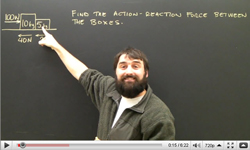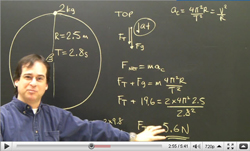Physics fundamentals find a home on YouTube in this issue’s NetWatch.
For past editions of NetWatch and additional sites for most topics can be found in the Archives.
by Lynda Scarrow
research by Olivia Krowicka
Earl Haig teachers embrace social media
This issue’s NetWatch takes a slight detour to cover some groundbreaking web work by two Toronto-based Earl Haig SS physics teachers.
Mark Caruana, OCT, and Adam Morin, OCT, have posted more than 40 physics lessons on YouTube.
“I was using YouTube videos to learn guitar,” says Caruana. “It struck me that videos would work well for physics lessons because students could watch them repeatedly to pick up points they missed the first time through.”
 Typically, Caruana and Morin shoot approximately 12 videos in a five-hour session.
Typically, Caruana and Morin shoot approximately 12 videos in a five-hour session.
“This may seem like a large investment of time, but the benefits for our students make it entirely worthwhile, and the videos can conceivably be used for years to come,” says Caruana.
The focus is on basic concepts and skills, because if students don’t fully master the basics, they will continue to struggle throughout the course.
“We discuss what we’re going to do in the video for a few minutes, make a quick calculation if necessary and then begin shooting. If we run into a problem we do a quick rethink and then reshoot, but in general we do these in one take,” says Caruana.
To create the videos, Caruana and Morin use a tripod-mounted $220 Sanyo Xacti camera at 720 pixels resolution and edit with free-to-download Movie Maker.
“Beverley Ohashi, the principal at our school, has been very supportive and helped us find time to continue making videos. As a result, we just finished 21 more and plan to make another set before the end of the school year,” says Morin.
“Despite our winning personalities and sunny dispositions, some students are reluctant or embarrassed to ask for help,” says Caruana. But the videos encourage students to approach them. The teachers were quite surprised when students started asking questions that indicated they had watched the videos closely and probably several times.
The videos don’t eliminate the need to ask questions and get clarification, but students find them great for review before a test or outside school hours when a teacher is unavailable. “This also gives them the opportunity to learn at their own pace when it’s convenient for them,” says Caruana.
The most exciting part of the project for both teachers has been the wonderful feedback and encouragement they have received – and not only from their own students.
“It’s very gratifying to come home each day and open my e-mail to find enthusiastic letters from students all over the world thanking us for providing the lessons,” says Morin. “We frequently get letters from Australia, the US, India, Saudi Arabia, Taiwan and China. One week, for some reason, we were very popular in Pakistan.”
The videos are also a welcome resource for Ontario teachers.

Adam Morin and Mark Caruana
“While they are by no means Hollywood productions, they are excellent resources,” says Joe Benforte, OCT, a five-year veteran physics and math teacher at Walkerville CI in Windsor. “They don’t replace in-class lessons, but they reinforce concepts covered in class.
“They’re presented in a logical order, so you can find the topic you need easily. And each one is only three to seven minutes long, which is a major bonus.”
Benforte found both the discussion and the solution of problems very thorough. “I sifted through a few to compare them with how I would teach the same topics, and I may use some of their strategies in my own lessons, since we have similar teaching styles.”
Caruana advises teachers thinking of making their own video resources not to hesitate. “Once you get that first video up on YouTube, you’ll find that watching the number of views increase becomes very addictive.
“And if you’re interested but feel you lack the technical expertise, you could assign this as a student project and post the best submissions.”
Additional Resources:
http://www.physics.org/
http://physics.aps.org/
http://www.physicsclassroom.com/
http://physicsworld.com/
http://www.physicsgames.net/
http://physics.info/
Lynda Scarrow is the College’s web editor. She can be reached at lscarrow@oct.ca.
